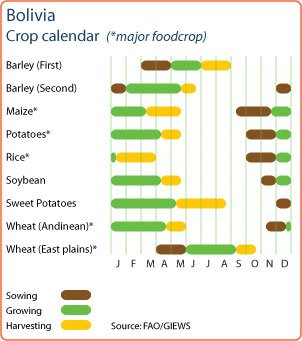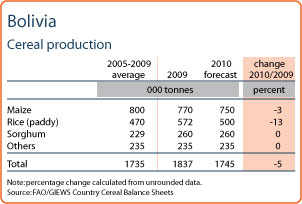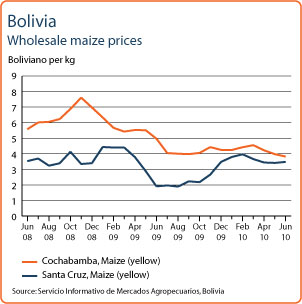Bolivia: Bolivia Agriculture Profile 2012
2012/02/22
Bolivia Agriculture Profile 2012
Reference Date: 30-May-2011
|
FOOD SECURITY SNAPSHOT
|
Increase in cereal yield, excluding rice, predicted for 2011
Harvesting of the main cereal crops of 2011 is almost complete. Despite a notable delay in sowing caused by dry weather in the last few months of 2010, the abundant rainfall from mid-January 2011 was generally beneficial for the development of the main maize crops. Early estimates indicate a 4 percent increase in maize production compared to the average for last year, due to higher yields. However, a decrease in rice crops is expected as these were more affected by the dry weather during sowing season and by localized flooding.
2010 cereal yield higher than in 2009
The total production of cereals in 2010 (winter and summer harvests) was estimated at 2.07 million tonnes (rice with husk), 6 percent higher than the 2009 harvest and the average amount. A sharp increase in yields of rice was recorded.
Prices of rice and maize decrease but prices of wheat flour increase
Prices of yellow maize decreased in the last two months in the country's main markets, with the main harvest of 2011. In May, at the Santa Cruz market, maize was valued at 37.5 Boliviano per arroba [weight equivalent to 11 502 kg], 5 percent lower than the month before and 4 percent lower than in May last year. In addition, prices of rice have fallen since March with the new harvest and in May were around 5 percent lower than last year. In May, prices of wheat flour, which is largely imported, continued to follow the increasing trend that began halfway through 2010 mirroring the increase on the international markets. In Santa Cruz, wheat flour was valued at 203 Boliviano/45kg, 21 percent higher than in May 2010.
Reference Date: 10-February-2011
|
FOOD SECURITY SNAPSHOT
|
Prospects for 2011 cereals are uncertain
The main cereals producing areas of Santa Cruz, Chuquisaca, Cochabamba and Tarija were seriously affected by drought during the last quarter of 2010 and cereals’ planting has been delayed. However, from mid January 2011, rainfall has been satisfactory even in some areas as Tarija has been reported flash floods as a result of rising of river levels and also hailstorm that damage crops in early February. Due to climate vagaries the cereals prospects for the 2011 cropping season are uncertain so far.
2010 cereals output estimated to be average but below 2009
Total cereals production (winter and summer seasons) should be about 1.745 million tonnes (unhulled rice), 5 percent below the good 2009 levels, but still average. The reduced output is due to the smaller sown acreages, particularly for maize, because of the low prices at sowing time as a result of a government decree (since withdrawn) limiting exports, which increased stocks. Poor rainfall during the agricultural season, particularly in the regions of Chaco and Santa Cruz, reduced crop yields. Rice production fell most steeply, by 13 percent below last year's output.
Cereals prices are rising
The price of wheat flour, which is mostly imported, increase in La Paz 15% compared with January 2010 (one year ago). Rice prices which fell from the beginning of 2010 increase 12 percent from July 2010 to January 2011 however still below 3 percent compared with January 2010 (one year ago).
In Cochabamba and Santa Cruz, yellow maize prices, start rising since August and October 2010 respectively. The high price of yellow maize is pushing up poultry production costs.
 The sowing of cereals for the 2010/11 agricultural season, mainly maize and rice, is in progress. The sowing prospects are favourable following the good rainfall in October, particularly in the main producing zones of the Department of Santa Cruz de la Sierra.
The sowing of cereals for the 2010/11 agricultural season, mainly maize and rice, is in progress. The sowing prospects are favourable following the good rainfall in October, particularly in the main producing zones of the Department of Santa Cruz de la Sierra. Total cereals production (winter and summer seasons) should be about 1.745 million tonnes (unhulled rice), 5 percent below the good 2009 levels, but still average. The reduced output is due to the smaller sown acreages, particularly for maize, because of the low prices at sowing time as a result of a government decree (since withdrawn) limiting exports, which increased stocks. Poor rainfall during the agricultural season, particularly in the regions of Chaco and Santa Cruz, reduced crop yields. Rice production fell most steeply, by 13 percent below last year's output.
Total cereals production (winter and summer seasons) should be about 1.745 million tonnes (unhulled rice), 5 percent below the good 2009 levels, but still average. The reduced output is due to the smaller sown acreages, particularly for maize, because of the low prices at sowing time as a result of a government decree (since withdrawn) limiting exports, which increased stocks. Poor rainfall during the agricultural season, particularly in the regions of Chaco and Santa Cruz, reduced crop yields. Rice production fell most steeply, by 13 percent below last year's output. The price of wheat flour, which is mostly imported, rose steeply during September because of the sharp increase in international prices. Wheat flour was sold on the La Paz market in mid-November 2010 at BOB 198/pound, 13 percent above the August price. In Santa Cruz, Cuban yellow maize prices, which had been rising since June this year, stabilized at record levels in October and at the beginning of November. The high price of yellow maize is pushing up poultry production costs.
The price of wheat flour, which is mostly imported, rose steeply during September because of the sharp increase in international prices. Wheat flour was sold on the La Paz market in mid-November 2010 at BOB 198/pound, 13 percent above the August price. In Santa Cruz, Cuban yellow maize prices, which had been rising since June this year, stabilized at record levels in October and at the beginning of November. The high price of yellow maize is pushing up poultry production costs. 
Bolivia is a world leader in the production of coca, which is widely grown on the warm eastern slopes of the Andes, where it has largely replaced many traditional crops. The dried leaves yield cocaine, which is smuggled to a number of Western nations, especially the United States. In places like Oriente, farmers are engaged in raising cattle, and cultivating rice, soybeans, and sugarcane.
- Related Articles
-
东帝汶农业概况
2012/08/27 更多
-
- Bolivia News
-
- AFGHANISTAN: Global growth will be disappointing in 2016: IMF's Lagarde
- AFGHANISTAN: Revised IMF forecasts signal gloom on global economic outlook
- AFGHANISTAN: Oxfam Study Finds Richest 1% Is Likely to Control Half of Global Wealth by 2016
- BOLIVIA: Brazil Retail Sales Rise More Than Forecast In August
- BOLIVIA: Brazilian regrets Paraguay did not follow the path of Venezuela, Ecuador and Bolivia
- BOLIVIA: President Evo Morales
- Trending Articles
-
- BAHAMAS: Brand New Residences Bring Modern Luxury Living to Paradise Island Bahamas
- TUNISIA: Tunisia augments ICT exports and connectivity
- EAST TIMOR: East Timor’s Finance
- GHANA: Ghana steps up to secure electricity supply
- WORLD: Mobilizing Education for Global Health
- CHINA: Support from China for the industrialisation of Angola and Mozambique






